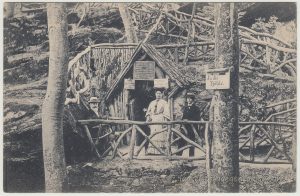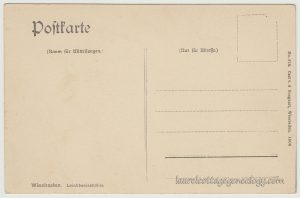Divided back, unused postcard. Publisher or printer: Carl v. d Boogaart, Wiesbaden, 1906.
Price: $7.00
Two trees (wonder if they could still be there?) form a passageway…..to a certain location in a German forest, circa 1906. Behind a rustic wooden fence, three people pose on a front porch…..There’s a small pointed roof over a doorway…..and a jungle-gym-like mass of wooden branches attached….
We know this is a destination of some sort from the signs that are posted. But click on the image to enlarge (check out the graffiti on the tree trunks)…..That conglomeration of tree limbs is actually a railing for a walkway leading up a hill. Then with a quick internet search…..ahhhh, that doorway is a cave entrance.
Google translation to English from Wikipedia entry with photos:
The Leichtweißhöhle is originally a small natural cave and not much more than a large rock overhang, a so-called abri . The local shale is not suitable for karstification . There are no other caves.
The cave was forgotten until Wiesbaden gained international renown as a spa and the cave developed into a popular excursion destination. It represented one of the new attractions that were to be offered to visitors to Wiesbaden. The Wiesbaden Beautification Association expanded the cave in 1856. A second entrance was created, a room on the side and a niche padded with moss, which was declared as a place to sleep. The cave was also decorated accordingly, including old weapons and pictures. A romanticization followed . The Schwarzbach coming from the Rabengrund and passing the cave received an artificial waterfall and a wooden bridge was built to cross the stream. A viewing pavilion was built above the cave, and the access paths to the cave were equipped with railings and the cave entrance with a wooden porch. These changes were so extensive that the original state can hardly be recognized today.
In 1905 Kaiser Wilhelm II visited the cave with his wife.
In 1934 the Gestapo used the Leichtweißhöhle as a torture cellar .
With the decline of the Wiesbaden cure, especially after the end of the Second World War , the cave lost its importance and was closed. The outdoor facilities were badly affected by vandalism and lack of maintenance. The cave was often used as a shelter. In 1983 the entrance was completely renewed. Since then, the cave has been regularly opened to visitors every six months.”
Sources: Leichtweißhöhle. n.d. https://de.wikipedia.org/wiki/Leichtwei%C3%9Fh%C3%B6hle. (accessed August 30, 2020).
Google translate (accessed August 30, 2020).




